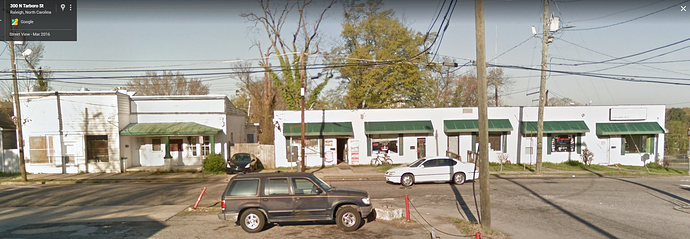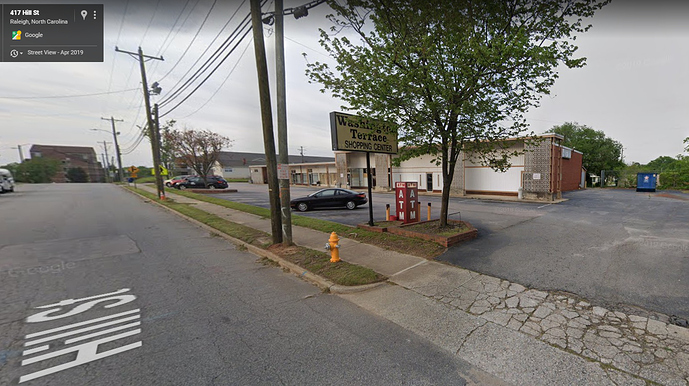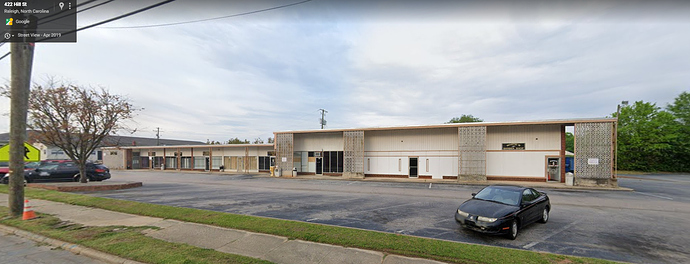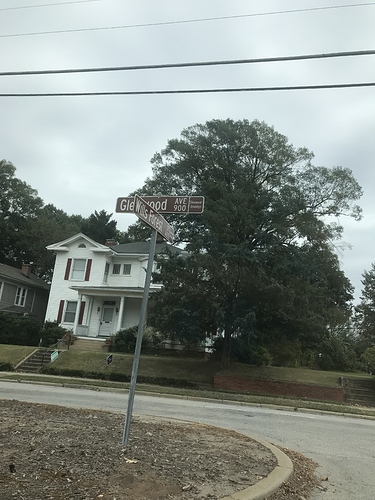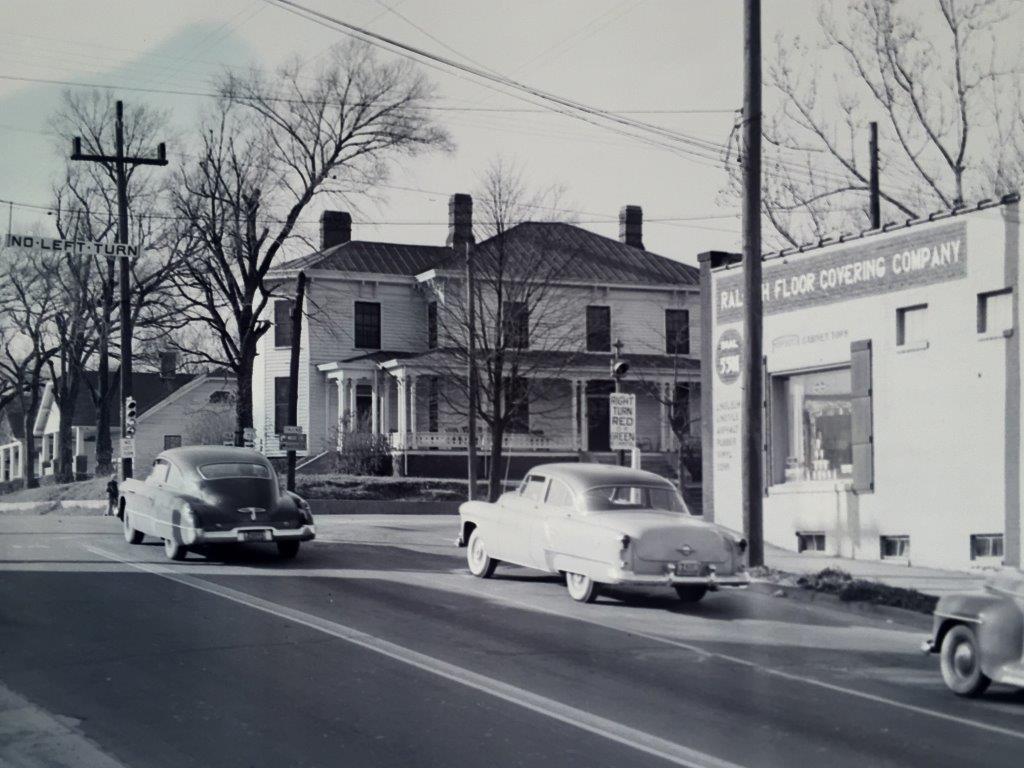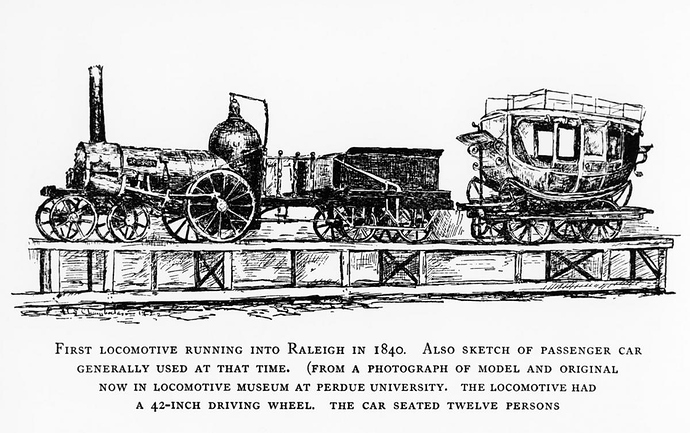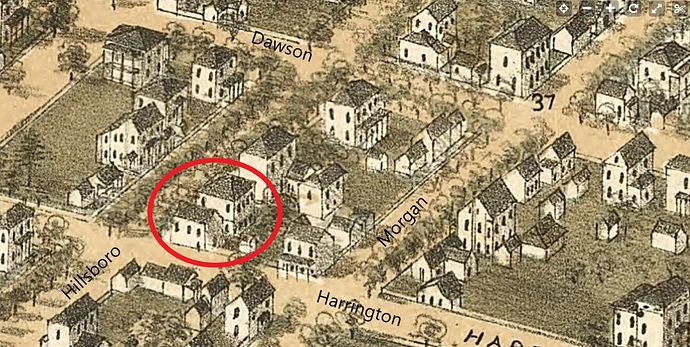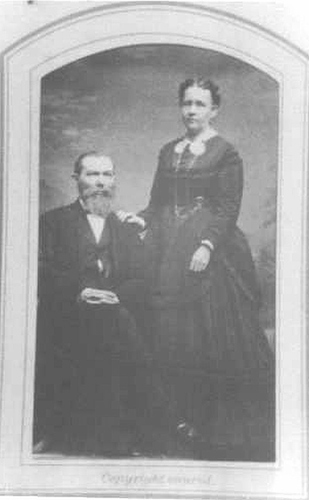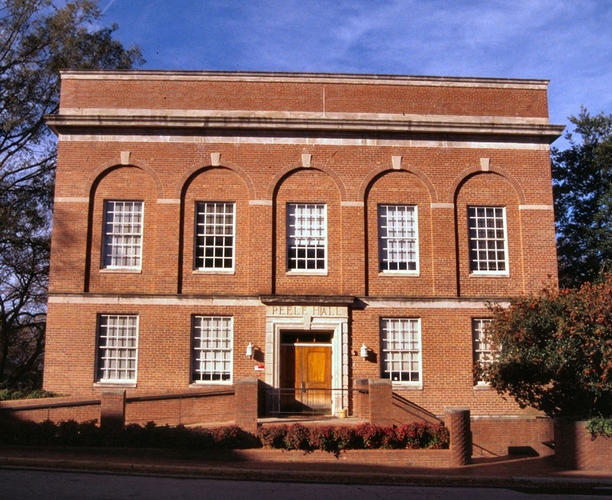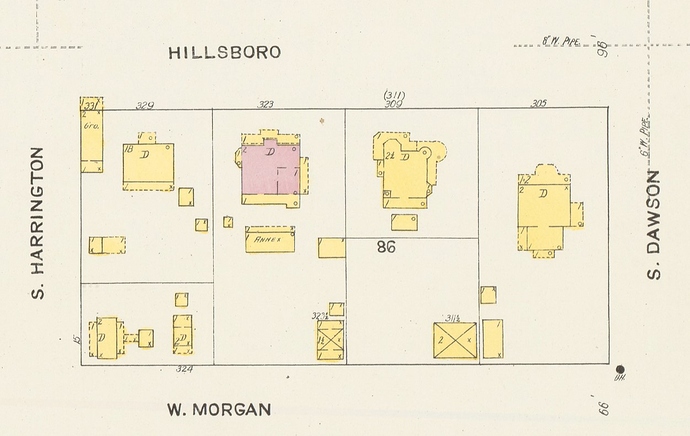In my mind I loop this in with the idea that we don’t have any kind of bohemian arts(y) district. I think those places spring up where there are old buildings and areas with “good bones” that are not too expensive. Where is there any of that left in Raleigh? The city only had 20,000 people back in the 1920s, and all those old buildings seem spoken for at this point. Transfer Co is probably a good example of what we get instead of dive bars. I see these two buildings on my bus ride home and think they are almost inevitably going to have dive bars at some point in the future, but might just end up being something more trendy.
andThe Glenwood Brooklyn part
Well, NC State, with The City’s help, chased off all the bars on Hillsborough St, Are you from here? It was like dirty 6th in Austin in its heyday and still had a nearly impossible hillsborough hike up until a decade ago.
These may be helpful …
https://localwiki.org/raleigh/History_for_Historic_Glenwood-Brooklyn_Neighborhood
The John Devereux Mansion sat just south of Tilden St. You can still sort of make out the big flat area and one large tree is beside the current house. Also the John Hinsdale mansion (yes he apparently also owned the Second Empire, Dodd-Hinsdale house) sat astride what is now Hinsdale St. It was later moved to what is now the Peace St Inspection parking lot. Attached is a copy of the Hinsdale home.
Does anyone happen to know of any images of Two Hannover Sq (aka bb&t, soon to be truist building) and the Wells Fargo building being built in the late 80’s/early 90’s that can be shared with me? There have been pictures from the 80s and 90s but I feel like the early 90s we’re generally skipped over.
Memories of 329 Hillsboro
Albert Sidney Johnson (1813-1897), originally from King William County, VA was an engineer with the recently created Richmond & Fredericksburg railroad. He came to Raleigh in 1836 to observe the beginnings of the nascent Raleigh & Gaston Railroad, but then returned to Richmond to be with his new wife, Sarah Elizabeth Brumley (1818-1905) and establishing his family there. As the Raleigh & Gaston completed their initial line, Mr. Johnson was hired on with the company as an engineer and tasked with the responsibility of operating the first locomotive to the new shops in Raleigh.
With great fanfare, Mr. Johnson and his conductor brought the newly built locomotive, ‘Tornado’ in on a snowy March 21, 1840. Built by the D. J. Burr Company in Richmond, the engine was considered a technological feat for its time and named for its considerable speed, reportedly being able to clear the 86 miles from Gaston to Raleigh in twelve hours.
That being said, operations were not entirely robust compared to contemporary standards. The tracks were built using Irish-forged strap iron nailed to linear wooden planks then affixed to the cross ties. This made movements prone to frequent derailment requiring those on board to manually re-rail the 1.5-ton engine. If the rail straps became dislodged, known as ‘snake heads’, the nails could be quickly launched through the floor of the carriage and through the skulls of any unfortunate individual in their way. Also, steam generation for motive power was wood fired. If the tender was depleted before arrival, those on board would have to chop down any available tree or neighboring fence line to replenish the fuel supply.
[Representative Picture of the Tornado]
He quickly moved through the ranks of the company rising to the level of Master Mechanic and Supervisor of Shops. Under his watch, the tracks were rebuilt with iron rails and larger motive power was purchased. With his position secure, he moved his family to Raleigh taking occupancy of a previously built two-story frame house on the southeastern corner of Hillsboro and Harrington (the western portion of Block 86 which had been designated as Plot 185 on the original Christmas Plan of 1797). This home eventually received the street address of 329 Hillsboro once the use of house numbers came into active practice by 1881.
[Drei’s Bird’s Eye View of Raleigh 1872 - Highlighting the Johnson house and store]
Johnson became quite admired in the community to the point of even being appointed to the board of directors to the North Carolina Rail Road which was the first time that an individual who had actually been a railroad employee was given that role. At a later point, the Raleigh & Gaston (now Seaboard Air Line) built a second roundhouse (with its currently extant turntable) and cross street both being named after him as well.
[Raleigh & Gaston/Seaboard Air Line’s Johnson Roundhouse turntable]
As he grew older, Johnson’s responsibilities to the companies decreased somewhat retiring on pension after 50 years with the railroad, carrying the title of being the oldest engineer in the country. He had already subdivided his property to build a small grocery store on the southeast corner of Hillsboro and Harrington sharing the responsibility of operation with his brother. At varying times over the years, their three daughters and their young families made their residence there with them. This was particularly true for many families during the recession era which occurred during Reconstruction. One of Johnson’s daughters, Mary Johnson Bellamy (1842-1929) and a grand-daughter, Sarah Elizabeth ‘Lizzie’ Bellamy (1871-1948), were long-time boarders at the residence.
[Albert Sidney Johnson and Sarah Brumley Johnson]
In 1897, Mr. Johnson died at the age of 84 after a brief illness leaving the home to his wife and the grocery store to his brother. His wife already had done what many families had to do during the pre-Social Security era, take in non-family boarders to supplement the household finances. One of the these was a Raleigh native, Ernest Patrick Maynard (1854-1925), who had just finished law school in 1879 at the recently reopened University of North Carolina. He later convinced one of his UNC classmates and Northampton County native, William Joseph Peele (1855-1919) to join him in Raleigh creating the Peele and Maynard law firm which was located for quite some time at 239 S Wilmington.
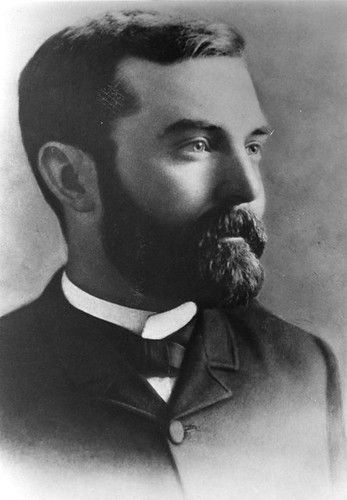
[Portrait – William Joseph Peele]
Peele was described as ‘a philosopher, a dreamer, and a planner.’ He surveyed the educational establishments of Raleigh at the time finding a lack of training beyond what would be described as the basics. In 1884, he founded the Watauga Club, a group of young men whose primary goal soon became the establishment of an industrial school for the training of farmers, mechanics, and manufacturers. With their efforts, and getting some pushback from their alma mater at the University of North Carolina, the land grant college of the North Carolina College of Agriculture and Mechanic Arts (now North Carolina State University) was created.
Peele was active on many other fronts. He promoted the first chair of history at The University of North Carolina and after serving (1891–97) on the board of trustees, he acted in a similar capacity for the North Carolina College of Agriculture and Mechanics beginning in 1899. In 1897 he formed the North Carolina Publishing Society to bring out Lives of Distinguished North Carolinians, which he compiled. His other books were Index to the Law of Exemptions in North Carolina of Homestead and Personal Property (1892) and Civil Government of North Carolina and the United States (1907).
In 1901 he helped organize the State Literary and Historical Association and was chairman of the committee to draft its constitution. The next year he was involved in the Roanoke Island Celebration Committee. Peele drew up one of the first lists of North Carolina books. In 1903 he wrote the bill for the establishment of the North Carolina Historical Commission, was primarily responsible for nursing it through the General Assembly, was appointed by Governor Charles B. Aycock as one of its first five members, served as its first chairman, and remained on the commission with (Gen.) Daniel Harvey (D. H. ) Hill until his death in 1919.
In spite of his many interests, Peele led a lonely life. His renowned eloquence and felicitous literary style were placed in the service of a more history-conscious, more cultured, and more prosperous North Carolina. “One could not conceive of Peele as a careless, frolicsome boy; he was always old,” wrote his friend Robert W. Winston. “Great sums of money simply terrified him! He could not understand how people got rich honestly.” His efforts to the college were rewarded posthumously with the naming of Peele Hall in 1928 which currently stands on campus serving as the Office for Undergraduate Admissions.
[Peele Hall - North Carolina State University]
Maynard married Mississippi native Albertine Crudup in 1895 moving out to 504 E Jones. Peele stayed on at Mrs. Johnson’s boarding house establishing and maintaining a twenty-one-year courtship with the owner’s previously mentioned grand-daughter, Sarah Elizabeth ‘Lizzie’ Bellamy. Elizabeth was among one of Raleigh’s first public school teachers, starting first at Centennial School in 1896 (previously the Governor’s Palace and now the site of Memorial Auditorium) and later rising to the level of principal of Raleigh Industrial School in 1905. On September 4, 1909, Peele and Bellamy were eventually married – he was 54, and she was 38.
[Block 86 - Sanborn Fire Insurance Maps, 1909]
They moved out to 118 N Dawson along with her mother, Joanna Mary Bellamy. Continuing to teach, she also served as a book editor for her husband. In 1905, after her grandmother died at the age of 87, Elizabeth took on the responsibility of running the boarding house. However, this proved to be an unsuccessful task with the boarding house and her grandfather’s grocery store on the corner being foreclosed on in 1911 and had to be sold at an auction on the steps of the county courthouse. The winning bid of $6550 was made by Henry T. Hicks, who then prepared the properties of 329/331 Hillsboro for demolition.
The Peele’s and Mrs. Bellamy stayed on at 118 N Dawson with William dying after a brief illness at the age of 64 in 1919, and Mrs. Bellamy dying in 1929 at the age of 87. Elizabeth continued book editing, first for News & Observer publisher Josephus Daniels. Then, she became the assistant to Henry London, head of the Legislative Reference Library. During that period, she wrote many bills for the legislators during sessions of the General Assembly drawing on her knowledge of law gained from her late husband. She also assisted in compiling and editing the North Carolina Manual. One of the outstanding pieces of work to her credit was an index to the public, local and private laws relating to the counties, cities and towns, from 1800 to 1945.
Her life ended tragically at the age of 77 in 1948 when she and two others were killed at Cox Crossing near the Fairgrounds when their car was hit by a Seaboard Air Line streamliner ‘Palmland.’ Many at the funeral saw the irony of her life and death involving the same railroad.
Most recently, her life and many other historical figures were featured prominently during a 2019 Burning Coal Theater Production, ‘Oakwood: 150 Years Young.’
[Elizabeth Bellamy Peele]
Sources:
Bird's eye view of the city of Raleigh, North Carolina 1872. | Library of Congress - Bird’s Eye View of Raleigh, North Carolina, 1872
The state chronicle. [volume] (Raleigh, N.C.) 1891-1893, September 03, 1891, Image 1 « Chronicling America « Library of Congress
Ancestry.com US Census Data (1850, 1870, 1880, and 1900)
Elizabeth Sarah Brumley Johnson (1818-1905) - Find A Grave Memorial
Hill’s City Directory of Raleigh – Multiple years: Digitized at UNC Library (Internet Archive Search: subject:"Raleigh (N.C.)--Directories.")
Peele, William Joseph | NCpedia
Elizabeth “Lizzie” Bellamy Peele (1871-1948) - Find A Grave Memorial
https://burningcoal.org/oakwood-at-150/
A nice read to on a sleepy Sunday morning. Thanks.
Going in to this, I had no prior knowledge of these people. But, these three were intertwined with the history of that corner, and their stories deserved a dusting off.
Johnson was celebrated for being a strong decision-maker and archetype of the ‘Common Man.’
Peele was a driven genius, and we are still benefiting from his efforts to this day.
Bellamy showed some amazing skills even though she had no formal training beyond a basic education. That she stood up and persevered through some pretty significant life events was incredible.
These weren’t wealthy elite, politically connected, or military leaders. Just typical and seemingly average. But, they accomplished quite a bit for our young city.
Chapter Two is coming.
I’d love to see those photos as well. Too bad that smartphones weren’t invented by then. We are going to have amazing records of development starting in 2010 because of them.
Article from WRAL exploring the history of the old Raleigh Municipal Airport, and what remains of it now:
Really interesting article! I never new Earhart and Rickenbacker flew into Raleigh. Crazy to think it’s somewhat still there!
Another interesting article linked in the story: 10 lost icons. So many of these have a place in my heart and history.
- Ihop on Hillsborough was where my family ate its first breakfast when we moved to Raleigh in 1974.
- Velvet Cloak (Charter Room) was where I had dinner for Senior Prom.
- Sadlack’s Heroes was a hang out when I went to State in the 80s.
- Mission Valley Cinema is where I first saw the South Park cartoon as a trailer before seeing Silence of the Lambs.
- Andy’s Pizza opened when my family first moved to Raleigh.
As also posted in another thread, here are some shots from the 60s and 70s by Mike Legeros and Vanished Raleigh:
C. 1969
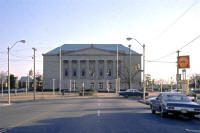
C. 1975

C. 1975
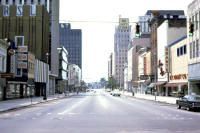
C. 1961

C. 1969

C. 1969

C. 1971

C. 1972
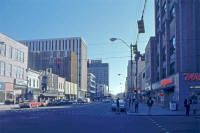
C. 1980

C. 1977
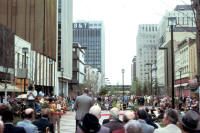
C. 1978 (with a fountain!)

C. 1974

There are labels for these images and more pictures at History by Mike Legeros - Vanished Raleigh, including historic houses, Cameron Village, North Hills, Falls Lake, and RDU.
Interesting. Has changed less than you might expect in 50 years.
OMG. The old Central Prison building would have made an EXCELLENT centerpiece to a vibrant urban district adjacent to Dix Park. What a lost opportunity.
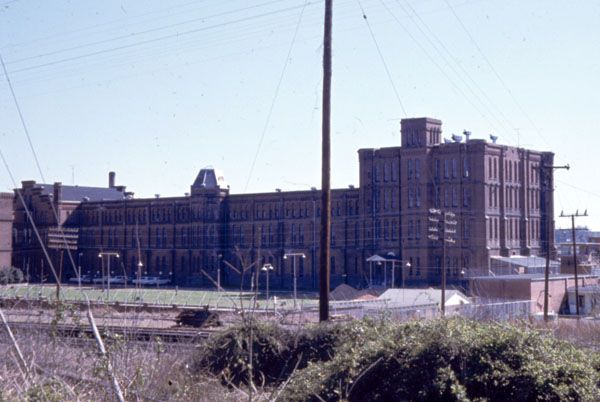
WOW that looks cool.
Probably felt different from the inside… 
I mean… yeah. File that under “No Sh!t” lmao - regardless of its purpose, its a cool looking building.
